HSC230 Assessment 2: Cultural Safety Action Plan Report
VerifiedAdded on 2022/10/17
|9
|1557
|12
Report
AI Summary
This report presents a comprehensive cultural safety action plan designed for nursing practice, focusing on effective communication, cultural competence, and patient-centered care. The plan outlines specific goals, objectives, strategies, and resources to foster a safe and inclusive environment for patients from diverse cultural backgrounds. It addresses potential barriers to effective communication, such as language differences and cultural misunderstandings, and proposes strategies to overcome them, including cultural competence training and improved health literacy. The rationale section emphasizes the importance of cultural safety in nursing, referencing relevant literature and the need for nurses to reflect on their own cultural values. The report also details evaluation methods, such as reflective journaling, performance appraisals, and patient surveys, to assess the effectiveness of the action plan and identify areas for further improvement. The goal is to create an environment where patients feel safe and empowered to make informed decisions about their health.
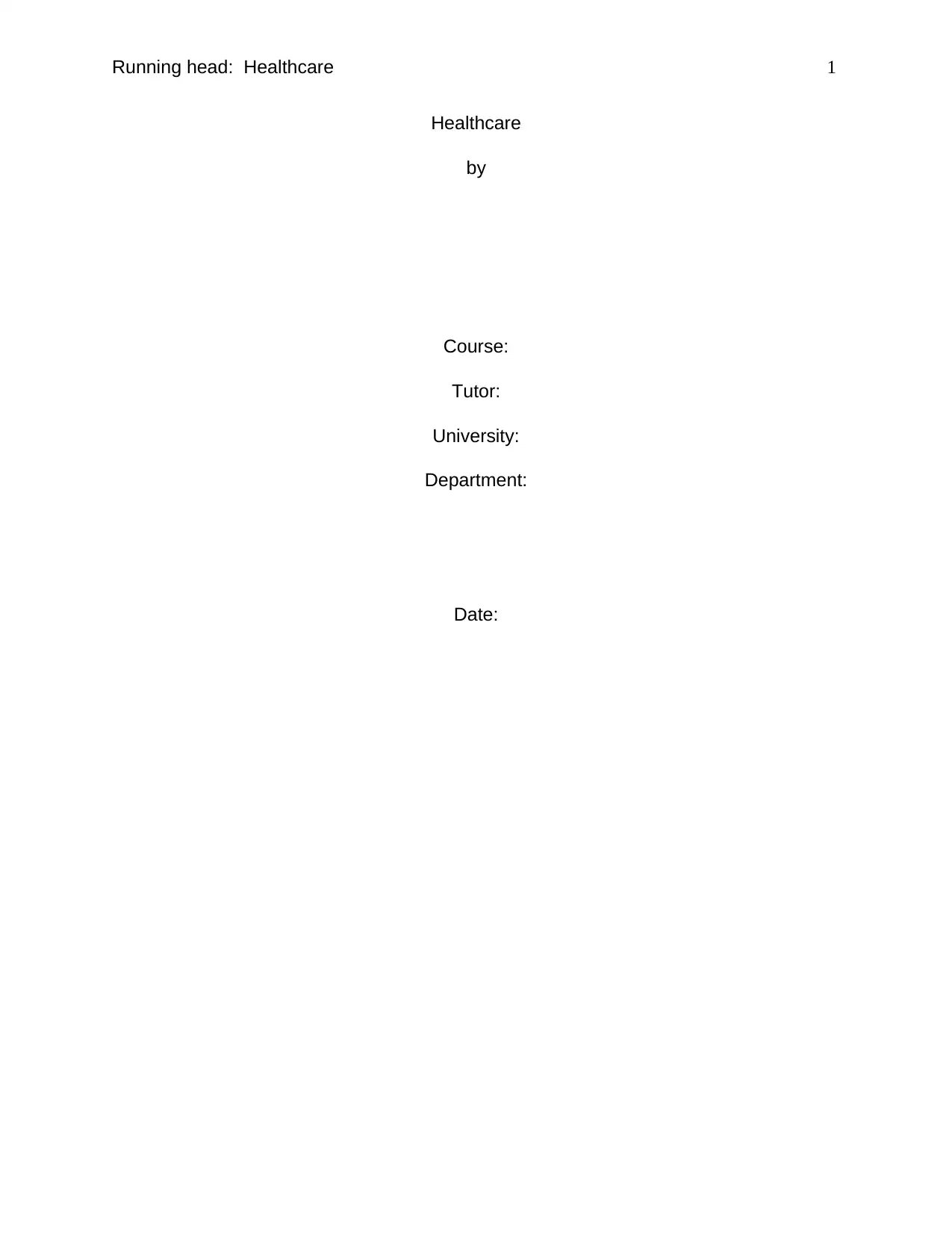
Running head: Healthcare 1
Healthcare
by
Course:
Tutor:
University:
Department:
Date:
Healthcare
by
Course:
Tutor:
University:
Department:
Date:
Paraphrase This Document
Need a fresh take? Get an instant paraphrase of this document with our AI Paraphraser
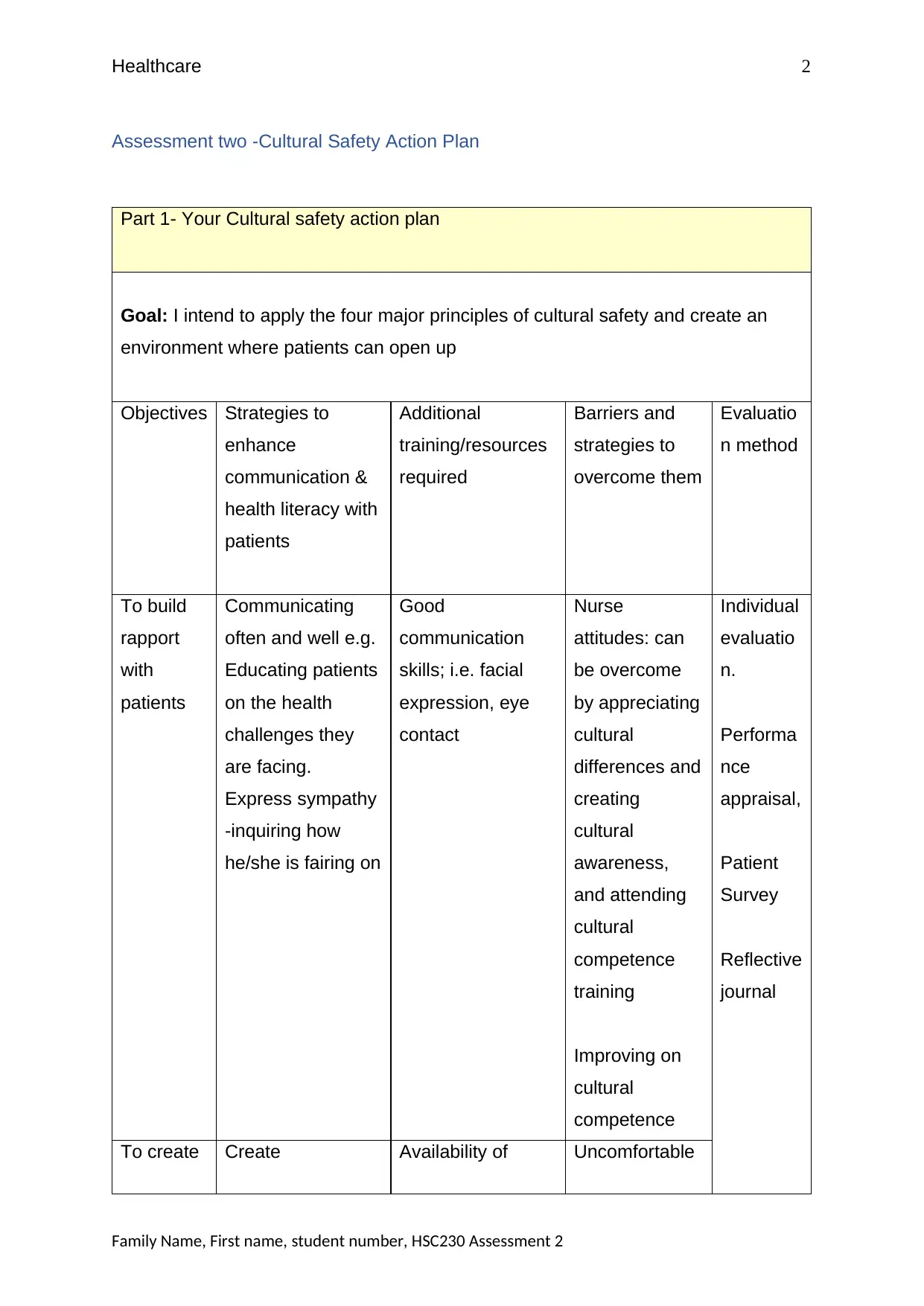
Healthcare 2
Assessment two -Cultural Safety Action Plan
Part 1- Your Cultural safety action plan
Goal: I intend to apply the four major principles of cultural safety and create an
environment where patients can open up
Objectives Strategies to
enhance
communication &
health literacy with
patients
Additional
training/resources
required
Barriers and
strategies to
overcome them
Evaluatio
n method
To build
rapport
with
patients
Communicating
often and well e.g.
Educating patients
on the health
challenges they
are facing.
Express sympathy
-inquiring how
he/she is fairing on
Good
communication
skills; i.e. facial
expression, eye
contact
Nurse
attitudes: can
be overcome
by appreciating
cultural
differences and
creating
cultural
awareness,
and attending
cultural
competence
training
Improving on
cultural
competence
Individual
evaluatio
n.
Performa
nce
appraisal,
Patient
Survey
Reflective
journal
To create Create Availability of Uncomfortable
Family Name, First name, student number, HSC230 Assessment 2
Assessment two -Cultural Safety Action Plan
Part 1- Your Cultural safety action plan
Goal: I intend to apply the four major principles of cultural safety and create an
environment where patients can open up
Objectives Strategies to
enhance
communication &
health literacy with
patients
Additional
training/resources
required
Barriers and
strategies to
overcome them
Evaluatio
n method
To build
rapport
with
patients
Communicating
often and well e.g.
Educating patients
on the health
challenges they
are facing.
Express sympathy
-inquiring how
he/she is fairing on
Good
communication
skills; i.e. facial
expression, eye
contact
Nurse
attitudes: can
be overcome
by appreciating
cultural
differences and
creating
cultural
awareness,
and attending
cultural
competence
training
Improving on
cultural
competence
Individual
evaluatio
n.
Performa
nce
appraisal,
Patient
Survey
Reflective
journal
To create Create Availability of Uncomfortable
Family Name, First name, student number, HSC230 Assessment 2
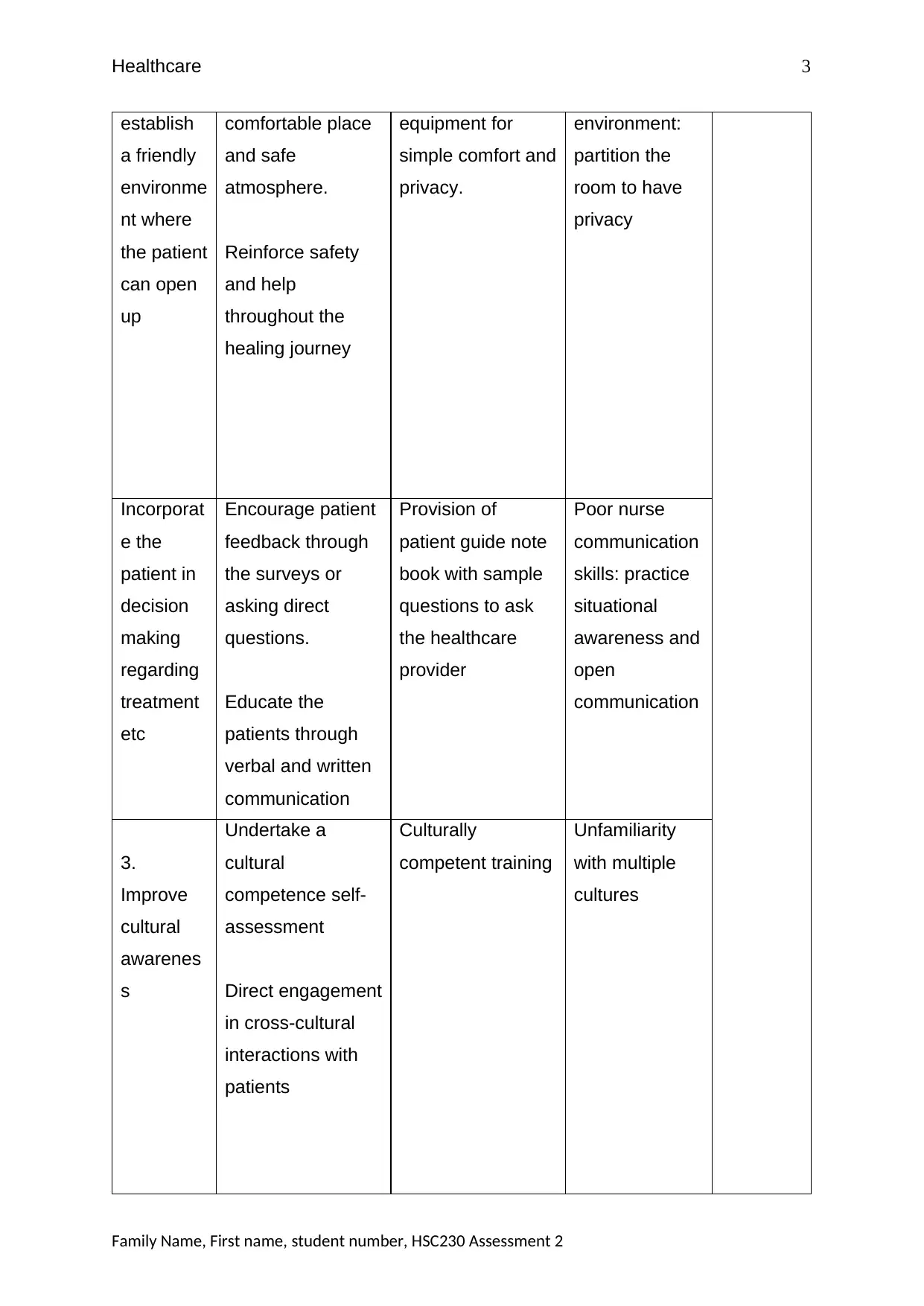
Healthcare 3
establish
a friendly
environme
nt where
the patient
can open
up
comfortable place
and safe
atmosphere.
Reinforce safety
and help
throughout the
healing journey
equipment for
simple comfort and
privacy.
environment:
partition the
room to have
privacy
Incorporat
e the
patient in
decision
making
regarding
treatment
etc
Encourage patient
feedback through
the surveys or
asking direct
questions.
Educate the
patients through
verbal and written
communication
Provision of
patient guide note
book with sample
questions to ask
the healthcare
provider
Poor nurse
communication
skills: practice
situational
awareness and
open
communication
3.
Improve
cultural
awarenes
s
Undertake a
cultural
competence self-
assessment
Direct engagement
in cross-cultural
interactions with
patients
Culturally
competent training
Unfamiliarity
with multiple
cultures
Family Name, First name, student number, HSC230 Assessment 2
establish
a friendly
environme
nt where
the patient
can open
up
comfortable place
and safe
atmosphere.
Reinforce safety
and help
throughout the
healing journey
equipment for
simple comfort and
privacy.
environment:
partition the
room to have
privacy
Incorporat
e the
patient in
decision
making
regarding
treatment
etc
Encourage patient
feedback through
the surveys or
asking direct
questions.
Educate the
patients through
verbal and written
communication
Provision of
patient guide note
book with sample
questions to ask
the healthcare
provider
Poor nurse
communication
skills: practice
situational
awareness and
open
communication
3.
Improve
cultural
awarenes
s
Undertake a
cultural
competence self-
assessment
Direct engagement
in cross-cultural
interactions with
patients
Culturally
competent training
Unfamiliarity
with multiple
cultures
Family Name, First name, student number, HSC230 Assessment 2
⊘ This is a preview!⊘
Do you want full access?
Subscribe today to unlock all pages.

Trusted by 1+ million students worldwide
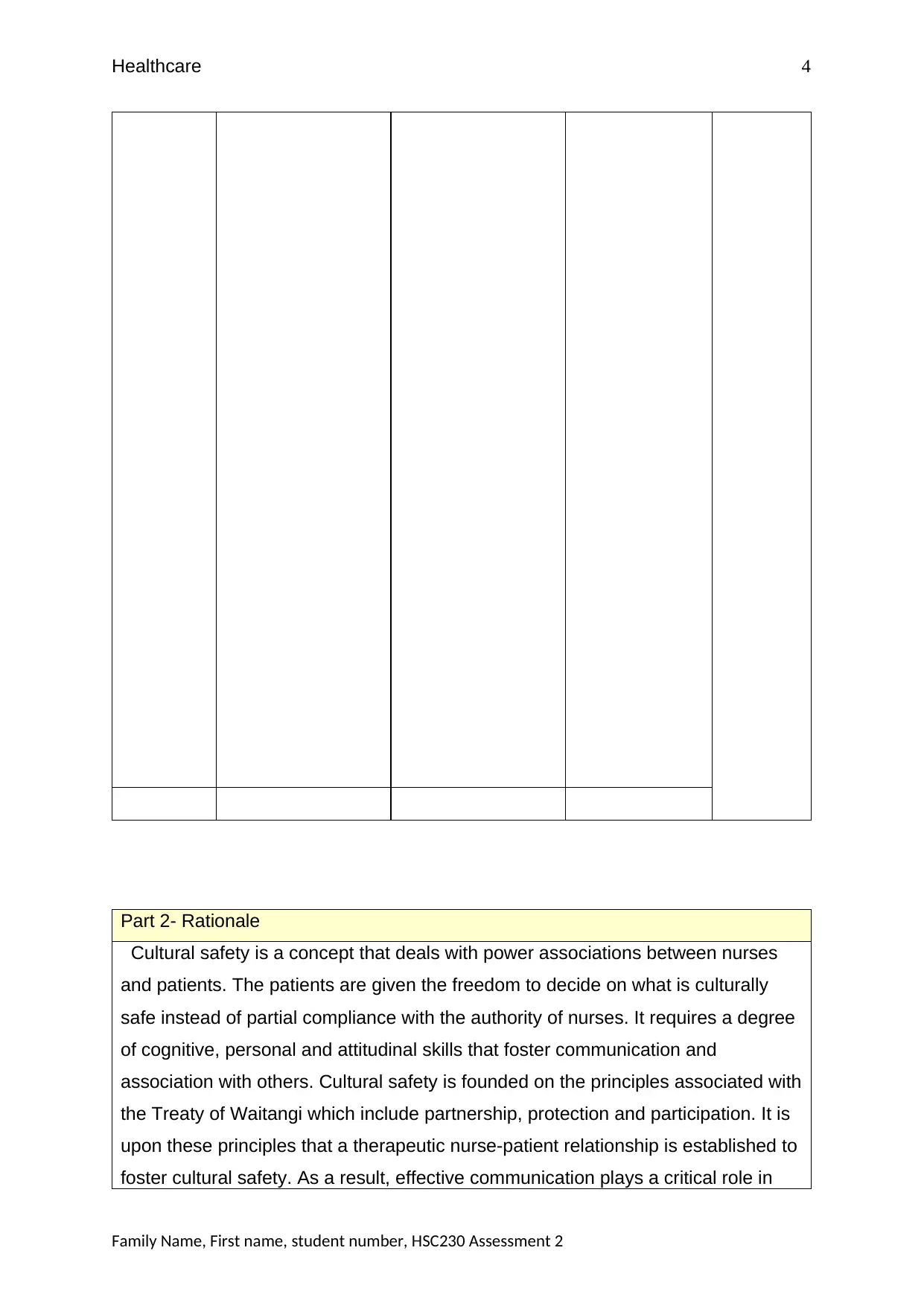
Healthcare 4
Part 2- Rationale
Cultural safety is a concept that deals with power associations between nurses
and patients. The patients are given the freedom to decide on what is culturally
safe instead of partial compliance with the authority of nurses. It requires a degree
of cognitive, personal and attitudinal skills that foster communication and
association with others. Cultural safety is founded on the principles associated with
the Treaty of Waitangi which include partnership, protection and participation. It is
upon these principles that a therapeutic nurse-patient relationship is established to
foster cultural safety. As a result, effective communication plays a critical role in
Family Name, First name, student number, HSC230 Assessment 2
Part 2- Rationale
Cultural safety is a concept that deals with power associations between nurses
and patients. The patients are given the freedom to decide on what is culturally
safe instead of partial compliance with the authority of nurses. It requires a degree
of cognitive, personal and attitudinal skills that foster communication and
association with others. Cultural safety is founded on the principles associated with
the Treaty of Waitangi which include partnership, protection and participation. It is
upon these principles that a therapeutic nurse-patient relationship is established to
foster cultural safety. As a result, effective communication plays a critical role in
Family Name, First name, student number, HSC230 Assessment 2
Paraphrase This Document
Need a fresh take? Get an instant paraphrase of this document with our AI Paraphraser
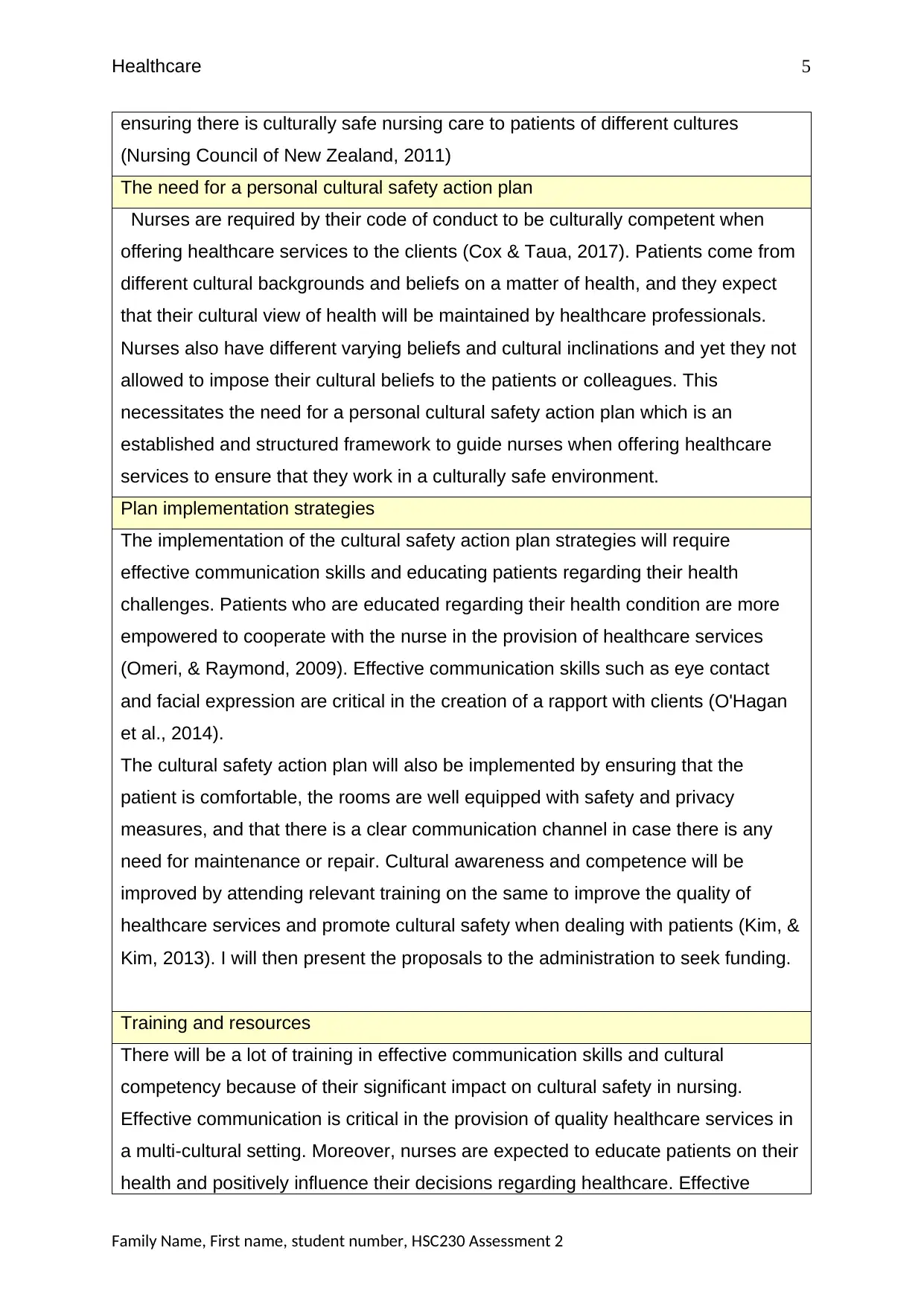
Healthcare 5
ensuring there is culturally safe nursing care to patients of different cultures
(Nursing Council of New Zealand, 2011)
The need for a personal cultural safety action plan
Nurses are required by their code of conduct to be culturally competent when
offering healthcare services to the clients (Cox & Taua, 2017). Patients come from
different cultural backgrounds and beliefs on a matter of health, and they expect
that their cultural view of health will be maintained by healthcare professionals.
Nurses also have different varying beliefs and cultural inclinations and yet they not
allowed to impose their cultural beliefs to the patients or colleagues. This
necessitates the need for a personal cultural safety action plan which is an
established and structured framework to guide nurses when offering healthcare
services to ensure that they work in a culturally safe environment.
Plan implementation strategies
The implementation of the cultural safety action plan strategies will require
effective communication skills and educating patients regarding their health
challenges. Patients who are educated regarding their health condition are more
empowered to cooperate with the nurse in the provision of healthcare services
(Omeri, & Raymond, 2009). Effective communication skills such as eye contact
and facial expression are critical in the creation of a rapport with clients (O'Hagan
et al., 2014).
The cultural safety action plan will also be implemented by ensuring that the
patient is comfortable, the rooms are well equipped with safety and privacy
measures, and that there is a clear communication channel in case there is any
need for maintenance or repair. Cultural awareness and competence will be
improved by attending relevant training on the same to improve the quality of
healthcare services and promote cultural safety when dealing with patients (Kim, &
Kim, 2013). I will then present the proposals to the administration to seek funding.
Training and resources
There will be a lot of training in effective communication skills and cultural
competency because of their significant impact on cultural safety in nursing.
Effective communication is critical in the provision of quality healthcare services in
a multi-cultural setting. Moreover, nurses are expected to educate patients on their
health and positively influence their decisions regarding healthcare. Effective
Family Name, First name, student number, HSC230 Assessment 2
ensuring there is culturally safe nursing care to patients of different cultures
(Nursing Council of New Zealand, 2011)
The need for a personal cultural safety action plan
Nurses are required by their code of conduct to be culturally competent when
offering healthcare services to the clients (Cox & Taua, 2017). Patients come from
different cultural backgrounds and beliefs on a matter of health, and they expect
that their cultural view of health will be maintained by healthcare professionals.
Nurses also have different varying beliefs and cultural inclinations and yet they not
allowed to impose their cultural beliefs to the patients or colleagues. This
necessitates the need for a personal cultural safety action plan which is an
established and structured framework to guide nurses when offering healthcare
services to ensure that they work in a culturally safe environment.
Plan implementation strategies
The implementation of the cultural safety action plan strategies will require
effective communication skills and educating patients regarding their health
challenges. Patients who are educated regarding their health condition are more
empowered to cooperate with the nurse in the provision of healthcare services
(Omeri, & Raymond, 2009). Effective communication skills such as eye contact
and facial expression are critical in the creation of a rapport with clients (O'Hagan
et al., 2014).
The cultural safety action plan will also be implemented by ensuring that the
patient is comfortable, the rooms are well equipped with safety and privacy
measures, and that there is a clear communication channel in case there is any
need for maintenance or repair. Cultural awareness and competence will be
improved by attending relevant training on the same to improve the quality of
healthcare services and promote cultural safety when dealing with patients (Kim, &
Kim, 2013). I will then present the proposals to the administration to seek funding.
Training and resources
There will be a lot of training in effective communication skills and cultural
competency because of their significant impact on cultural safety in nursing.
Effective communication is critical in the provision of quality healthcare services in
a multi-cultural setting. Moreover, nurses are expected to educate patients on their
health and positively influence their decisions regarding healthcare. Effective
Family Name, First name, student number, HSC230 Assessment 2
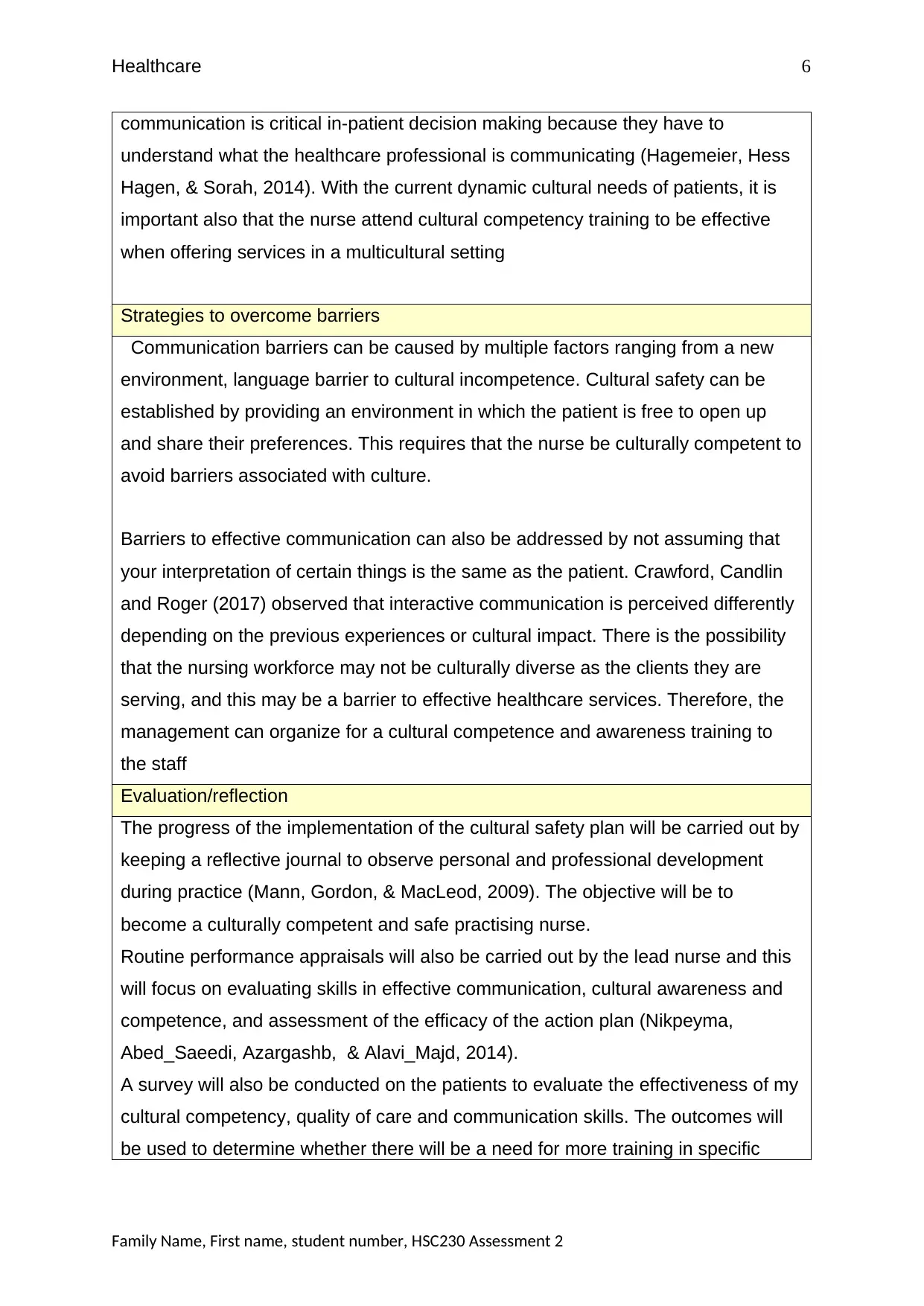
Healthcare 6
communication is critical in-patient decision making because they have to
understand what the healthcare professional is communicating (Hagemeier, Hess
Hagen, & Sorah, 2014). With the current dynamic cultural needs of patients, it is
important also that the nurse attend cultural competency training to be effective
when offering services in a multicultural setting
Strategies to overcome barriers
Communication barriers can be caused by multiple factors ranging from a new
environment, language barrier to cultural incompetence. Cultural safety can be
established by providing an environment in which the patient is free to open up
and share their preferences. This requires that the nurse be culturally competent to
avoid barriers associated with culture.
Barriers to effective communication can also be addressed by not assuming that
your interpretation of certain things is the same as the patient. Crawford, Candlin
and Roger (2017) observed that interactive communication is perceived differently
depending on the previous experiences or cultural impact. There is the possibility
that the nursing workforce may not be culturally diverse as the clients they are
serving, and this may be a barrier to effective healthcare services. Therefore, the
management can organize for a cultural competence and awareness training to
the staff
Evaluation/reflection
The progress of the implementation of the cultural safety plan will be carried out by
keeping a reflective journal to observe personal and professional development
during practice (Mann, Gordon, & MacLeod, 2009). The objective will be to
become a culturally competent and safe practising nurse.
Routine performance appraisals will also be carried out by the lead nurse and this
will focus on evaluating skills in effective communication, cultural awareness and
competence, and assessment of the efficacy of the action plan (Nikpeyma,
Abed_Saeedi, Azargashb, & Alavi_Majd, 2014).
A survey will also be conducted on the patients to evaluate the effectiveness of my
cultural competency, quality of care and communication skills. The outcomes will
be used to determine whether there will be a need for more training in specific
Family Name, First name, student number, HSC230 Assessment 2
communication is critical in-patient decision making because they have to
understand what the healthcare professional is communicating (Hagemeier, Hess
Hagen, & Sorah, 2014). With the current dynamic cultural needs of patients, it is
important also that the nurse attend cultural competency training to be effective
when offering services in a multicultural setting
Strategies to overcome barriers
Communication barriers can be caused by multiple factors ranging from a new
environment, language barrier to cultural incompetence. Cultural safety can be
established by providing an environment in which the patient is free to open up
and share their preferences. This requires that the nurse be culturally competent to
avoid barriers associated with culture.
Barriers to effective communication can also be addressed by not assuming that
your interpretation of certain things is the same as the patient. Crawford, Candlin
and Roger (2017) observed that interactive communication is perceived differently
depending on the previous experiences or cultural impact. There is the possibility
that the nursing workforce may not be culturally diverse as the clients they are
serving, and this may be a barrier to effective healthcare services. Therefore, the
management can organize for a cultural competence and awareness training to
the staff
Evaluation/reflection
The progress of the implementation of the cultural safety plan will be carried out by
keeping a reflective journal to observe personal and professional development
during practice (Mann, Gordon, & MacLeod, 2009). The objective will be to
become a culturally competent and safe practising nurse.
Routine performance appraisals will also be carried out by the lead nurse and this
will focus on evaluating skills in effective communication, cultural awareness and
competence, and assessment of the efficacy of the action plan (Nikpeyma,
Abed_Saeedi, Azargashb, & Alavi_Majd, 2014).
A survey will also be conducted on the patients to evaluate the effectiveness of my
cultural competency, quality of care and communication skills. The outcomes will
be used to determine whether there will be a need for more training in specific
Family Name, First name, student number, HSC230 Assessment 2
⊘ This is a preview!⊘
Do you want full access?
Subscribe today to unlock all pages.

Trusted by 1+ million students worldwide
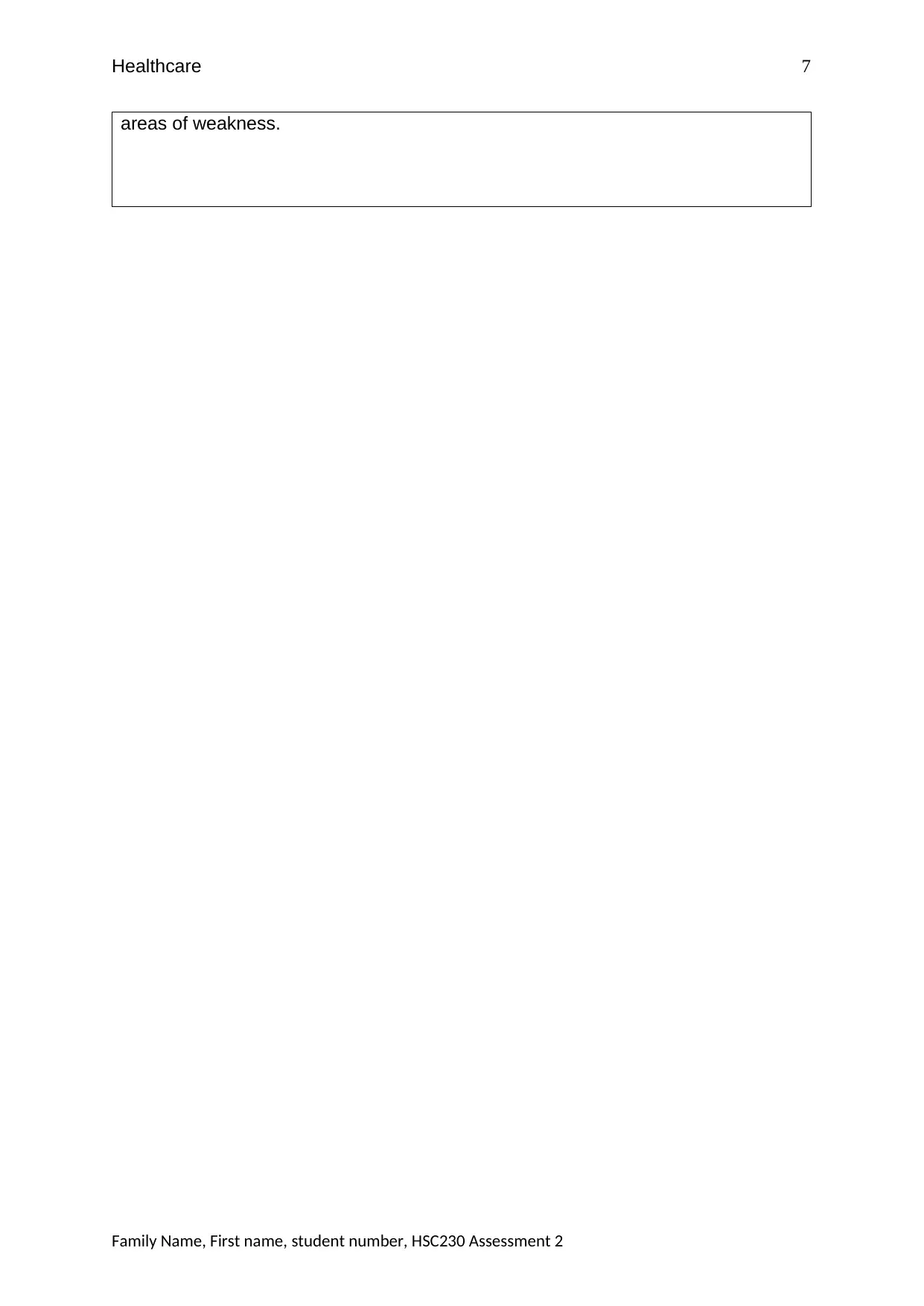
Healthcare 7
areas of weakness.
Family Name, First name, student number, HSC230 Assessment 2
areas of weakness.
Family Name, First name, student number, HSC230 Assessment 2
Paraphrase This Document
Need a fresh take? Get an instant paraphrase of this document with our AI Paraphraser
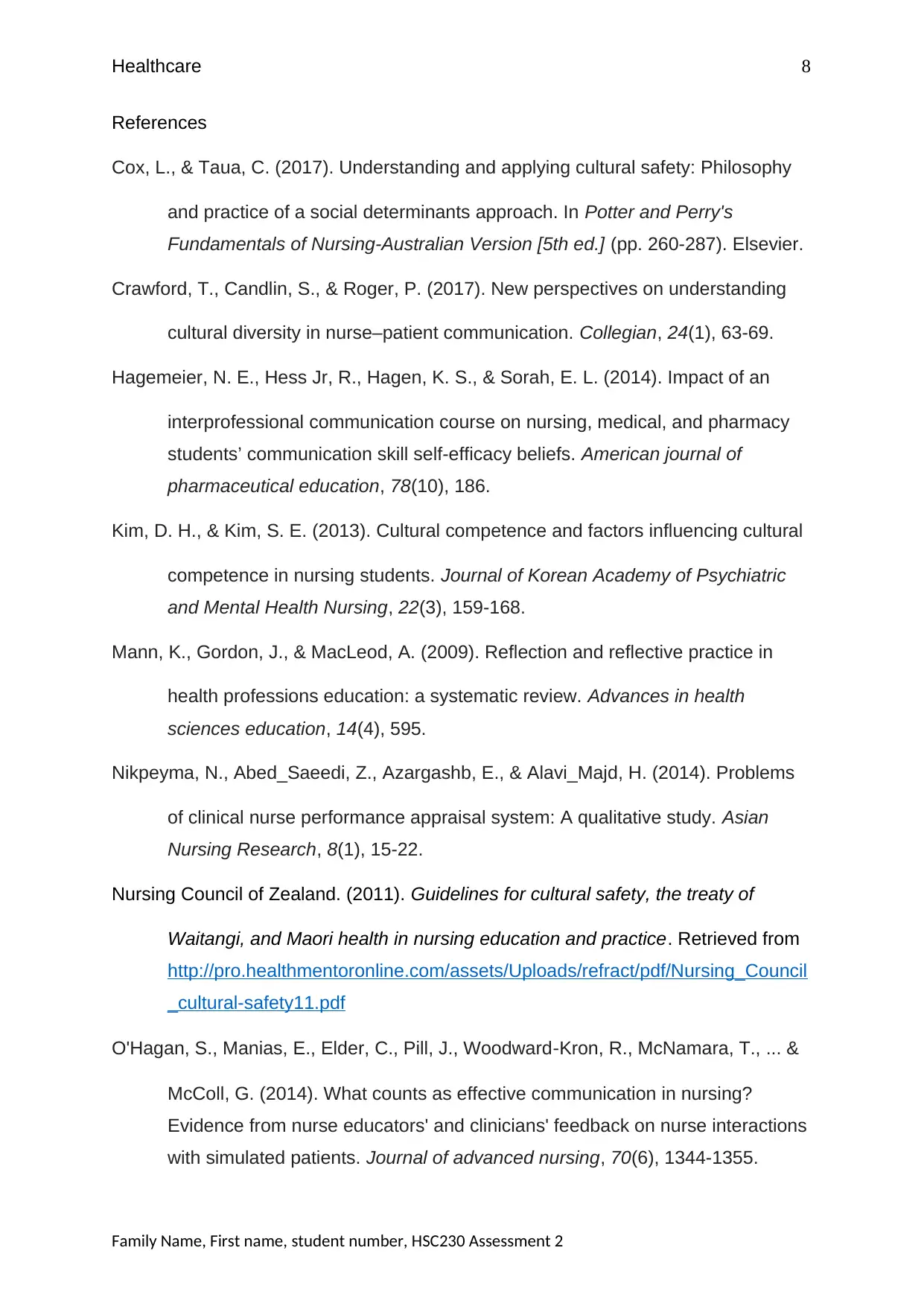
Healthcare 8
References
Cox, L., & Taua, C. (2017). Understanding and applying cultural safety: Philosophy
and practice of a social determinants approach. In Potter and Perry's
Fundamentals of Nursing-Australian Version [5th ed.] (pp. 260-287). Elsevier.
Crawford, T., Candlin, S., & Roger, P. (2017). New perspectives on understanding
cultural diversity in nurse–patient communication. Collegian, 24(1), 63-69.
Hagemeier, N. E., Hess Jr, R., Hagen, K. S., & Sorah, E. L. (2014). Impact of an
interprofessional communication course on nursing, medical, and pharmacy
students’ communication skill self-efficacy beliefs. American journal of
pharmaceutical education, 78(10), 186.
Kim, D. H., & Kim, S. E. (2013). Cultural competence and factors influencing cultural
competence in nursing students. Journal of Korean Academy of Psychiatric
and Mental Health Nursing, 22(3), 159-168.
Mann, K., Gordon, J., & MacLeod, A. (2009). Reflection and reflective practice in
health professions education: a systematic review. Advances in health
sciences education, 14(4), 595.
Nikpeyma, N., Abed_Saeedi, Z., Azargashb, E., & Alavi_Majd, H. (2014). Problems
of clinical nurse performance appraisal system: A qualitative study. Asian
Nursing Research, 8(1), 15-22.
Nursing Council of Zealand. (2011). Guidelines for cultural safety, the treaty of
Waitangi, and Maori health in nursing education and practice. Retrieved from
http://pro.healthmentoronline.com/assets/Uploads/refract/pdf/Nursing_Council
_cultural-safety11.pdf
O'Hagan, S., Manias, E., Elder, C., Pill, J., Woodward‐Kron, R., McNamara, T., ... &
McColl, G. (2014). What counts as effective communication in nursing?
Evidence from nurse educators' and clinicians' feedback on nurse interactions
with simulated patients. Journal of advanced nursing, 70(6), 1344-1355.
Family Name, First name, student number, HSC230 Assessment 2
References
Cox, L., & Taua, C. (2017). Understanding and applying cultural safety: Philosophy
and practice of a social determinants approach. In Potter and Perry's
Fundamentals of Nursing-Australian Version [5th ed.] (pp. 260-287). Elsevier.
Crawford, T., Candlin, S., & Roger, P. (2017). New perspectives on understanding
cultural diversity in nurse–patient communication. Collegian, 24(1), 63-69.
Hagemeier, N. E., Hess Jr, R., Hagen, K. S., & Sorah, E. L. (2014). Impact of an
interprofessional communication course on nursing, medical, and pharmacy
students’ communication skill self-efficacy beliefs. American journal of
pharmaceutical education, 78(10), 186.
Kim, D. H., & Kim, S. E. (2013). Cultural competence and factors influencing cultural
competence in nursing students. Journal of Korean Academy of Psychiatric
and Mental Health Nursing, 22(3), 159-168.
Mann, K., Gordon, J., & MacLeod, A. (2009). Reflection and reflective practice in
health professions education: a systematic review. Advances in health
sciences education, 14(4), 595.
Nikpeyma, N., Abed_Saeedi, Z., Azargashb, E., & Alavi_Majd, H. (2014). Problems
of clinical nurse performance appraisal system: A qualitative study. Asian
Nursing Research, 8(1), 15-22.
Nursing Council of Zealand. (2011). Guidelines for cultural safety, the treaty of
Waitangi, and Maori health in nursing education and practice. Retrieved from
http://pro.healthmentoronline.com/assets/Uploads/refract/pdf/Nursing_Council
_cultural-safety11.pdf
O'Hagan, S., Manias, E., Elder, C., Pill, J., Woodward‐Kron, R., McNamara, T., ... &
McColl, G. (2014). What counts as effective communication in nursing?
Evidence from nurse educators' and clinicians' feedback on nurse interactions
with simulated patients. Journal of advanced nursing, 70(6), 1344-1355.
Family Name, First name, student number, HSC230 Assessment 2
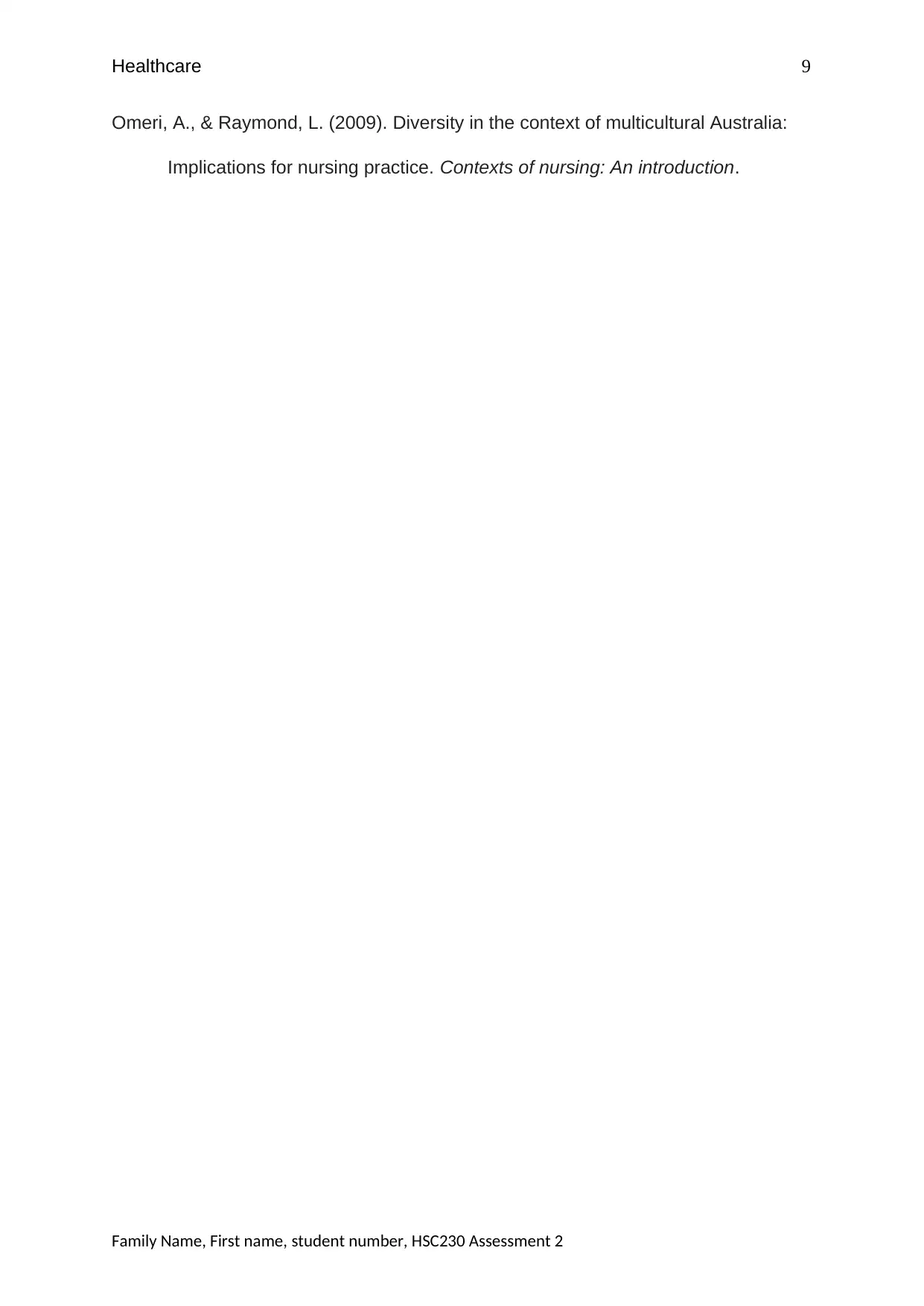
Healthcare 9
Omeri, A., & Raymond, L. (2009). Diversity in the context of multicultural Australia:
Implications for nursing practice. Contexts of nursing: An introduction.
Family Name, First name, student number, HSC230 Assessment 2
Omeri, A., & Raymond, L. (2009). Diversity in the context of multicultural Australia:
Implications for nursing practice. Contexts of nursing: An introduction.
Family Name, First name, student number, HSC230 Assessment 2
⊘ This is a preview!⊘
Do you want full access?
Subscribe today to unlock all pages.

Trusted by 1+ million students worldwide
1 out of 9
Related Documents
Your All-in-One AI-Powered Toolkit for Academic Success.
+13062052269
info@desklib.com
Available 24*7 on WhatsApp / Email
![[object Object]](/_next/static/media/star-bottom.7253800d.svg)
Unlock your academic potential
Copyright © 2020–2025 A2Z Services. All Rights Reserved. Developed and managed by ZUCOL.




